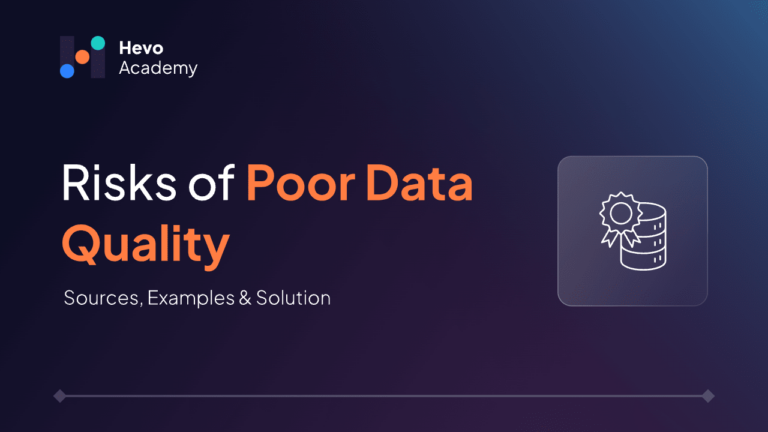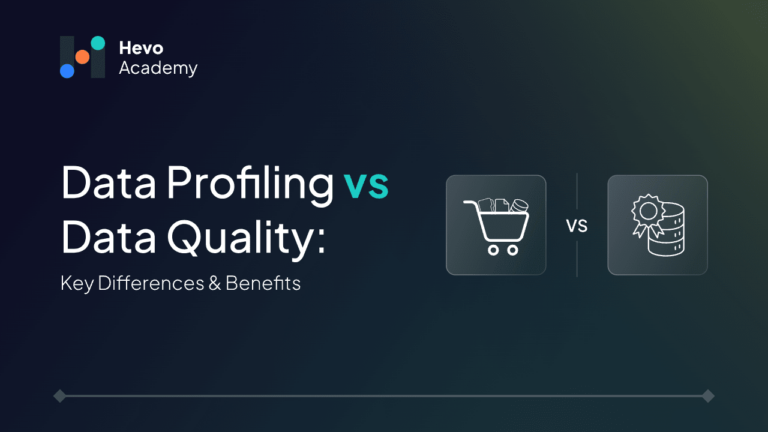Once debugged, the primary reason for bad data quality is clear: it is frequently incorrect, lacking, conflicting, or unimportant. These problems create significant dangers of low data quality for your company, resulting in missed chances, decreased profits, and harm to reputation.
Table of Contents
The stakes have never been higher in the current data lifecycle. While legacy systems were built with good intentions, they frequently lack robust processes for validating and checking data quality. This oversight creates a perfect storm of dirty data, which can mislead teams and erode customer trust.
This article will delve into these risks and offer practical advice on how your company can minimize them. Prioritizing data quality is crucial, from uncovering hidden costs to enacting successful improvement plans.
Reduce the risk of poor data quality with Hevo’s auto-schema mapping, ensuring your data stays accurate and consistent.
- High-Quality Data: Ensure reliable and clean data throughout the process.
- No-Code Interface: Migrate your data with zero coding effort.
- Auto-Schema Mapping: Automatically map complex schemas for error-free transfers.
What is meant by Poor Data Quality?
Flawed insights, wasted resources, and compliance issues—these are the consequences of poor data quality. When data is supposed to offer insights that drive your organization forward, the risk of poor data quality can be costly. Fixing data issues and dealing with errors can be expensive.
So, what is meant by poor data quality?
Bad data quality refers to data that is inaccurate, lacks information, has inconsistencies, or is irrelevant. This includes challenges such as:
- Typos: Minor mistakes in inputting data can result in major mistakes.
- Missing Values: Incomplete records can hinder analysis and decision-making.
- Repeated Records: Multiple instances of identical data can lead to disarray and inefficiencies.
- Outdated Information: Data that is not current can inaccurately depict present circumstances or patterns.
For instance, a company relying on customer data for its marketing campaigns needs accurate data. Bad data quality causes:
- Typos in names, for example, an email meant for “Juliet Riyan” might be sent to “Juliet Reeyan,” causing confusion.
- Incorrect Email Addresses such as “julietriyan@example.com” entered as “julietreeyan@example.com” leads to failed deliveries.
- Incomplete addresses, like missing address details, result in undelivered promotional materials and a waste of resources.
Sources of Poor Data Quality
To achieve high-quality data that:
- Provides a solid foundation for developing new products, services, and business models,
- Formulate long-term strategies with growth opportunities, and
- Personalized customer experiences
is often our goal. However, in our rush to achieve it, we tend to skip data screening steps, which leaves us with bad data quality. This data is unreliable and inconsistent.
On top of that, you usually discover this compromised data when you come across:
- Incorrect reports that do not accurately represent the real situation.
- Incorrect interpretation causes erroneous conclusions.
- Operational inefficiencies that result in a decrease in speed and an increase in errors.
- Customer dissatisfaction arises from inadequate service or incorrect information.
- Errors and inefficiencies cause extra expenses.
Common data quality issues like incomplete or inaccurate data can significantly increase operational risks, leading to unreliable analytics and poor business outcomes. To resolve and debug these data irregularities, we pinpoint 7 key sources that underscore the risk of poor data quality:
- Data Entry Errors occur when data is entered manually. Mistakes made by humans, such as typos and entering incorrect values, happen frequently. This results in inaccurate data storage, causing skewed analysis and decision-making.
- Tip: Use validation rules and automated data entry systems to reduce errors.
- Data Duplication occurs when data is combined from various sources without adequate verification. This results in repetition and disorientation, which in turn leads to overly high metrics and wasted resources.
- Tip: Utilize tools for removing duplicates and conduct routine data audits to clean up duplicate entries.
- Incomplete data occurs when there are missing fields in data collection forms or incomplete submissions. This leads to holes in the analysis, which hinders the ability to make precise conclusions.
- Tip: Make sure to complete the required fields when collecting data. Employ automated inspections to identify unfinished inputs.
- Outdated Data is discovered in outdated legacy systems and historical databases. Using outdated information can lead to missed opportunities and errors in strategy.
- Tip: Make sure to maintain and regularly update data sources. Establish procedures for managing data throughout its lifecycle.
- Inconsistent Data occurs when data is saved in varying formats among systems. This leads to problems with integration and errors in data analysis and reporting.
- Tip: Ensure that data formats remain uniform. Utilize data integration software to guarantee uniformity.
- Data Silos exist in isolated departments or systems.
- Tip: Encourage cooperation and sharing of information among different departments. Utilize centralized data storage resources.
- Lack of Data Governance results from the absence of data management policies. This leads to unregulated data handling, causing data breaches and compliance issues.
- Tip: Create and uphold data governance guidelines. Offer instruction on the most effective methods for managing data.
You can take a look at how data quality compares with data observability to get a better understanding of the two.
Impact of Poor Data Quality on a Business
Poor data quality costs organizations an average of $15 million annually. This immense reduction results from three main influences:
- Inaccurate data can result in massive financial setbacks, as companies may forfeit 30% of their income due to bad choices.
- Operational inefficiencies occur when employees dedicate up to half of their time to fixing data errors instead of concentrating on their main duties, which hampers productivity.
- Accurate customer data can cause significant reputational harm, resulting in unsatisfying interactions; 70% of customers are inclined to change brands following bad data management.
The risk of poor data quality aren’t just theoretical; they directly impact your finances and customer confidence, ultimately slowing down your business expansion. Therefore, consider the following: What is the real expense of inaccurate data for us? Are we ready to face the outcomes of decisions made with inaccurate information? These inquiries underscore companies’ need to address the dangers of inadequate data quality checks and put resources into effective data management strategies.
The Risk of Poor Data Quality: Real-World Case Studies
Let’s explore how poor data quality significantly impacted three industries. Each example highlights the risk of poor data quality, the issues involved, how they were discovered, and what steps could have been taken to mitigate losses.
Case Studies on the Risk of Poor Data Quality
1. Public Health England’s COVID-19 Reporting Error
Industry: Public Health
Problem Explained: During the COVID-19 pandemic, Public Health England failed to report thousands of positive cases due to a technical glitch in their data recording system.
Issues:
- A glitch in the software led to a major underestimation of the reported cases.
- This resulted in unreliable infection rates and public health reactions.
- Caused delays in putting in place essential health measures.
How it was discovered: The mistake was detected when differences between reported cases and true infections became noticeable, leading to a probe.
Connection to Risk of Poor Data Quality: This example shows that ineffective data handling can significantly impact public health, impacting both lives and healthcare plans.
Steps for Preventing Losses:
- Enhance data gathering and reporting mechanisms.
- Perform routine checks to ensure the precision of health data.
- Make sure that staff receive thorough training on procedures for handling data.
2. JPMorgan Chase Trading Loss (London Whale Incident)
Industry: Finance
Problem Explained: In 2012, JPMorgan Chase incurred a trading loss of $6.2 billion due to poor data quality in risk management models.
Issues:
- Inaccurate risk assessments resulted from flawed and incomplete data.
- The bank’s internal controls did not catch the discrepancies.
- Led to substantial financial loss and damage to reputation.
How it was discovered: The losses were revealed through regular financial reports, triggering an internal inquiry that exposed the extent of the data problems.
Connection to Risk of Poor Data Quality: This case underscores how poor data governance can lead to massive financial repercussions and erode stakeholder trust.
Steps to Avoid Losses:
- Enhance risk management frameworks with better data validation.
- Regularly audit and update risk assessment models.
- Train staff on the importance of accurate data reporting.
3. NASA Mars Climate Orbiter
Industry: Aerospace
Problem Explained: NASA lost the $125 million Mars Climate Orbiter due to a data error caused by inconsistent unit measurements.
Issues:
- One engineering team used metric units, while another used imperial units.
- This mismatch led to the spacecraft’s incorrect trajectory.
- The orbiter ultimately crashed into Mars, resulting in a total loss.
How it was discovered: The failure was identified during post-launch assessments when the orbiter failed to enter its intended orbit around Mars.
Connection to Risk of Poor Data Quality: This incident highlights how critical accurate data is in high-stakes environments like aerospace, where even minor errors can lead to catastrophic failures.
Steps to Avoid Losses:
- Standardize measurement units across all teams.
- Implement rigorous cross-checking protocols.
- Foster a culture of communication between departments.
Strategies for Improving Data Quality
Did you know poor data quality can cost organizations a whopping $12.9 million each year? It’s not just about the money, though. It messes with decision-making and operational efficiency. You can dodge these pitfalls by implementing solid data quality strategies and boosting overall business performance. Implementing strategies focusing on data quality metrics can help organizations monitor potential risks, allowing them to detect and address issues before they impact decision-making or analytics.
Top 5 Strategies to Implement
Data Governance
Set a structured framework and policies for managing your data assets. This includes defining roles, setting data standards, and ensuring compliance with regulations. Why? It ensures accuracy, accountability, and consistency in your data handling. This reduces risks and fosters a culture of data stewardship within your organization.
How to Implement?
- Form a dedicated data governance team.
- Develop comprehensive data policies.
- Conduct regular training sessions for your staff.
Data Cleansing and Deduplication
Data cleansing involves detecting and correcting (or removing) corrupt or inaccurate records from your dataset. Deduplication ensures data uniqueness by identifying and eliminating duplicate records. How does it support you? With improved and cleaned data, you achieve accuracy and reliability, which builds customer trust and enhances your analytics and reporting, improving operational efficiency.
How to Implement?
- Employ data cleansing tools to automate the process.
- Schedule regular data audits.
- Maintain a log of data corrections.
Data Profiling and Auditing
Data profiling involves examining data from an existing source and collecting statistics or summaries about that data. Auditing systematically reviews your data to ensure it meets quality standards. The impact? It maintains high data standards and supports continuous improvement by identifying root causes of data quality issues and implementing corrective measures.
How to Implement?
- Use data profiling tools to analyze data patterns.
- Conduct regular audits to verify data integrity.
- Implement corrective measures for identified issues.
Data Validation Techniques
Data validation ensures your data meets predefined standards and criteria before processing or storing, such as format, range, and consistency checks. How does this help you? It ensures data integrity from the start, reducing errors at entry. This reliability enhances your business intelligence and analytics efforts.
How to Implement?
- Integrate validation rules into your data entry processes.
- Use automated tools to enforce validation rules.
- Regularly update validation criteria.
Quick Tip: Recognizing the difference between data reliability and data validity is essential to mitigate quality risks, ensuring that data is both consistent and correctly represents the truth.Feedback Loops
Creating mechanisms for continuous feedback on data quality from users and stakeholders helps promptly identify and address data quality issues. Feedback loops offer quick resolution of data issues, adapt data quality strategies, and promote a culture of data quality to meet evolving business needs.
How to Implement?
- Establish channels for users to report data issues.
- Regularly review and act on feedback.
- Make necessary adjustments to your data processes.
Learn More about Data Quality:
Conclusion
To sum up, bad data quality creates substantial hazards that can result in significant expenses for your organization. Whether it’s errors in data entry or using obsolete systems, the outcome can result in decreased revenue and overlooked opportunities.
Traditional data structures may be robust, but they frequently lack the adaptability to integrate contemporary solutions that mitigate these risks. Deciding whether to use a data catalog or metadata management can seem daunting, especially with many choices available. This is where Hevo Data steps in. Our expertise lies in streamlining the data integration process, enabling you to concentrate on extracting insights instead of being overwhelmed by complexities.
Get in touch with us now to improve your data management and maximize your organization’s capabilities.
FAQs on Risk of Poor Data Quality
What are the risks of lack of data integrity?
When data integrity is compromised, data can be altered or corrupted, leading to several issues. Security breaches may occur, and sensitive information can be exposed due to unauthorized access or tampering. This can result in a loss of trust from customers and stakeholders, as unreliable data undermines confidence in your business. Additionally, inaccurate data can cause non-compliance with regulations, leading to fines and legal problems.
Why is the quality of data a concern?
High-quality data is essential for several reasons. It ensures accurate report analysis, which helps streamline processes and reduce costly errors. Reliable data also makes customer interactions smooth and personalized, enhancing satisfaction. High-quality data supports better decision-making, allowing businesses to operate more efficiently and effectively.
What are the five factors that contribute to poor-quality data?
Poor data quality often stems from several issues: mistakes during data entry or processing, outdated systems that can’t handle modern needs, inconsistent data formats and definitions across the organization, weak data governance with inadequate policies and procedures, and employees not properly trained in data management best practices. These factors can lead to significant inaccuracies and inefficiencies.
What are the six reasons why poor quality can occur?
Poor quality can occur due to:
– Not checking data for accuracy and completeness.
– No clear responsibility for data quality.
– Not enough tools or personnel to manage data properly.
– Miscommunication between departments leads to data inconsistencies.
– Employees not trained to handle data correctly.
– Using old systems that can’t support high-quality data management.






